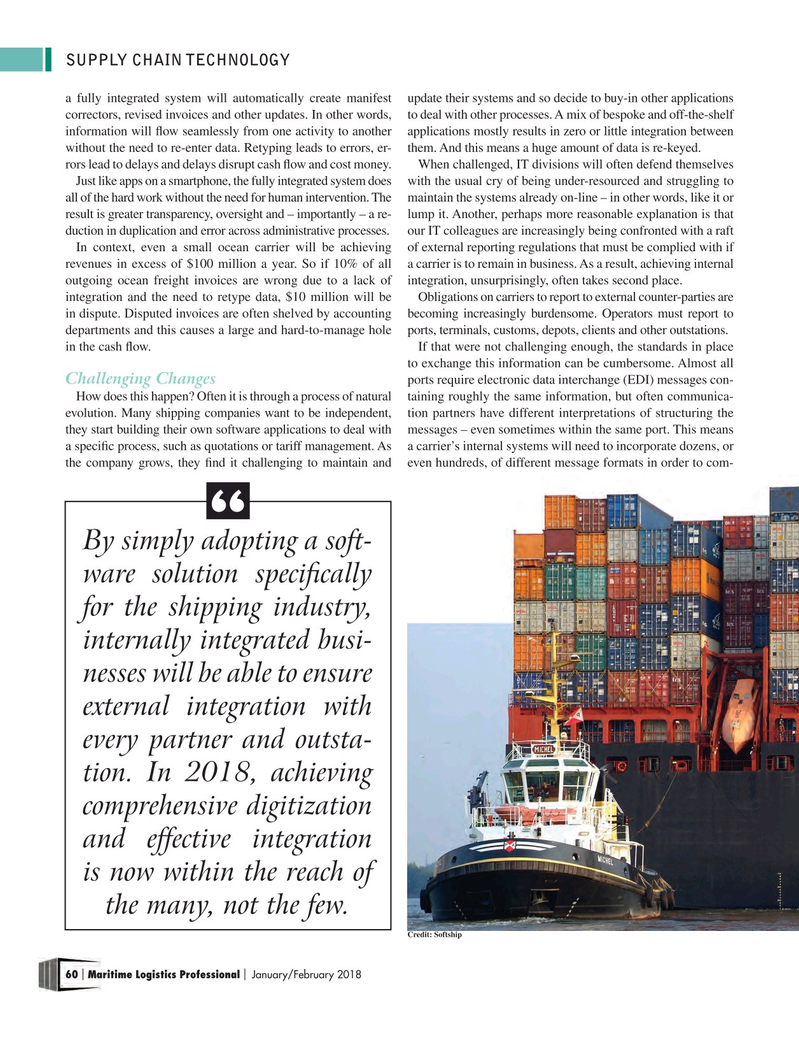
Page 60: of Maritime Logistics Professional Magazine (Jan/Feb 2018)
Cruise Shipping Trends
Read this page in Pdf, Flash or Html5 edition of Jan/Feb 2018 Maritime Logistics Professional Magazine
SUPPLY CHAIN TECHNOLOGY a fully integrated system will automatically create manifest update their systems and so decide to buy-in other applications correctors, revised invoices and other updates. In other words, to deal with other processes. A mix of bespoke and off-the-shelf information will ? ow seamlessly from one activity to another applications mostly results in zero or little integration between without the need to re-enter data. Retyping leads to errors, er- them. And this means a huge amount of data is re-keyed.
rors lead to delays and delays disrupt cash ? ow and cost money. When challenged, IT divisions will often defend themselves
Just like apps on a smartphone, the fully integrated system does with the usual cry of being under-resourced and struggling to all of the hard work without the need for human intervention. The maintain the systems already on-line – in other words, like it or result is greater transparency, oversight and – importantly – a re- lump it. Another, perhaps more reasonable explanation is that duction in duplication and error across administrative processes. our IT colleagues are increasingly being confronted with a raft
In context, even a small ocean carrier will be achieving of external reporting regulations that must be complied with if revenues in excess of $100 million a year. So if 10% of all a carrier is to remain in business. As a result, achieving internal outgoing ocean freight invoices are wrong due to a lack of integration, unsurprisingly, often takes second place.
integration and the need to retype data, $10 million will be Obligations on carriers to report to external counter-parties are in dispute. Disputed invoices are often shelved by accounting becoming increasingly burdensome. Operators must report to departments and this causes a large and hard-to-manage hole ports, terminals, customs, depots, clients and other outstations.
in the cash ? ow. If that were not challenging enough, the standards in place to exchange this information can be cumbersome. Almost all
Challenging Changes ports require electronic data interchange (EDI) messages con-
How does this happen? Often it is through a process of natural taining roughly the same information, but often communica- evolution. Many shipping companies want to be independent, tion partners have different interpretations of structuring the they start building their own software applications to deal with messages – even sometimes within the same port. This means a speci? c process, such as quotations or tariff management. As a carrier’s internal systems will need to incorporate dozens, or the company grows, they ? nd it challenging to maintain and even hundreds, of different message formats in order to com-
By simply adopting a soft- ware solution speci? cally for the shipping industry, internally integrated busi- nesses will be able to ensure external integration with every partner and outsta- tion. In 2018, achieving comprehensive digitization and effective integration is now within the reach of the many, not the few.
Credit: Softship 60 Maritime Logistics Professional January/February 2018 | |

 59
59

 61
61
